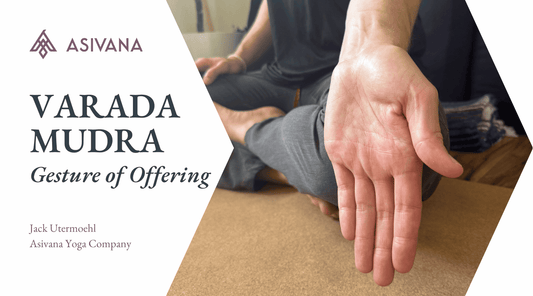
Padma Mudra - Lotus Seal
Jack UtermoehlShare
Padma Mudra (Lotus Seal)
Sanskrit Name: Padma Mudrā - पद्म मुद्रा
English Translation: Lotus Seal
Phonetic Spelling: PAD-mah Moo-Drah
Padma mudra, also known as the lotus seal, symbolizes purity, spiritual awakening, and love. The lotus is a powerful symbol in Eastern traditions, representing the ability to rise above difficulties, just as a lotus blooms beautifully despite growing in muddy waters.
Padma mudra is ideal for meditation focused on opening the heart, cultivating compassion, and finding inner peace. It is commonly used to connect with the divine or enhance personal growth, purity, and transformation.
By practicing this mudra, you activate Anahata (heart) chakra, allowing love and compassion to flow freely while healing emotional wounds. It is particularly beneficial for releasing emotional blockages and creating feelings of self-acceptance and unconditional love.

Instructions to Perform Padma Mudra
Sit comfortably in a chair or cross-legged on the floor, ensuring your spine is straight.
Hand Position: Bring your hands together in front of your chest in anjali mudra, palms facing each other. Keep the base of your palms, little fingers, and thumbs touching. Spread your other fingers wide apart, mimicking the petals of a blooming lotus.
Posture: Sit in sukhasana (easy pose) or padmasana (lotus pose), or practice in vrksasana (tree pose) to enhance balance and heart-opening.
Breathing Technique: Inhale deeply through your nose, imagining the blossoming of a lotus at your heart center. Exhale gently, releasing tension and opening yourself to love and compassion.
Duration: Practice for 5-10 minutes during meditation, focusing on love, peace, and transformation.
Benefits of Padma Mudra
Padma mudra enhances emotional clarity, self-acceptance, and compassion. It is a powerful tool for healing the heart and opening to spiritual growth.
Physical Benefits: Relieves tension in the chest and promotes relaxation. Enhances circulation and improves breath control.
Mental Benefits: Sharpens focus and calms the mind. Helps release emotional stress.
Emotional Benefits: Encourages feelings of love, compassion, and self-acceptance. Aids in emotional healing and the release of heart-centered blockages.
Spiritual Benefits: Activates the heart chakra, encouraging spiritual growth, love, and recognition of the light within the heart space.
Capture your insights and deepen your connection with our Yoga Journal.Elevate Your Mudra Practice
Symbolism and Meaning of Padma Mudra
Padma, meaning lotus, represents purity and spiritual awakening. The lotus grows in muddy waters yet blooms into a beautiful flower untouched by its surroundings, symbolizing our ability to rise above challenges and remain pure in heart and spirit.
Padma mudra honors this transformation, helping practitioners open their hearts to love and compassion while promoting emotional healing and balance.
This mudra is closely linked to the Anahata (heart) chakra, enhancing feelings of compassion, self-love, and connection to the divine. It is a powerful reminder of the strength and beauty we can embody, no matter our circumstances.
When to Practice Padma Mudra
Padma mudra is ideal for meditation focused on love, compassion, or personal transformation. It can be practiced during yoga sessions or while meditating to release emotional blockages and evoke peace. Use this mudra whenever you seek to reconnect with your heart center and open yourself to love and emotional balance.
Practice it for 5-10 minutes to experience its heart-opening benefits, especially in the evening when reflecting on your day or during meditation aimed at emotional healing.
Contraindications for Padma Mudra
Padma mudra is gentle and suitable for all practitioners. Those with hand discomfort may relax the finger placement or shorten the practice duration.
Additional Insights on Padma Mudra
Affirmations: "I open my heart to love and compassion." / "I blossom like the lotus, pure and strong."
Visualization: While holding padma mudra, visualize a beautiful lotus flower blooming at your heart center. Imagine it opening petal by petal, symbolizing your capacity for love, self-acceptance, and emotional healing.
Associated Chakras: Padma mudra primarily activates Anahata (heart chakra).
Paired Asanas: Padma mudra works well in standing postures like vrksasana (tree pose) at heart center or overhead. Seated postures like sukhasana (easy pose) are also a great place to practice this mudra.
Related Pranayama: Pair padma mudra with ujjayi breath or deep belly breathing to calm the mind and enhance emotional clarity.
Meditation Techniques: Ideal for loving-kindness meditation (metta meditation) or meditations focusing on heart-centered awareness, peace, and compassion.
Variations and Modifications
Alternative Hand Positions: Anjali Mudra, Ananta Mudra
Adaptations for Beginners: Beginners may hold padma mudra for shorter periods, such as 2 minutes, gradually increasing the duration. Let your finger relax while separated instead of stretching out.
—— 🕉 ——

Personal Insights
Padma mudra is the image and sensation of an unfolding lotus flower. The lotus grows in mud but from the mud emerges a vibrant flower untouched by the water or mud.
During my yoga practice, padma mudra is a radiant addition such as in tree pose (vrksasana). This is one of my favorite ways to perform the lotus mudra.
Coming into tree pose, find your balance, extend the arms overhead and form the lotus above your crown chakra. Turn your gaze to look up at the flower and ascend the mind from mud to flower.
Let me know your experience with padma lotus mudra in the comments below.











